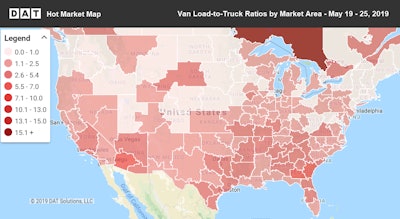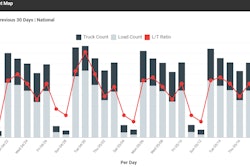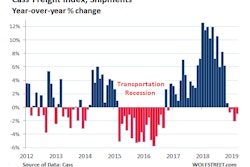Spot truckload freight volumes continued to build during the week ending May 26 as Memorial Day approached, and improving van and refrigerated load-to-truck ratios contributed to higher rates on major lanes, said DAT Solutions, which operates the DAT network of load boards. National average spot rates barely moved compared to the previous week, however.
National average spot rates through May 26
**Van: $1.80/mile, 1 cent lower than the April average
**Reefer: $2.16/mile, 1 cent higher than April
**Flatbed: $2.29/mile, 4 cents lower than April
Trend to watch: Urgency building in the van market
Rates were higher on 54 of the top 100 van lanes compared to the previous week and the national average van load-to-truck ratio rose from 1.6 to 1.8.
 That’s still below expectations for this time of the year.
That’s still below expectations for this time of the year.But look for more urgency among shippers and brokers as the end-of-month rush coincides with the four-day work week this week. We’re seeing it in Atlanta, which boasted the highest number of van load posts in the country last week. Rates between Atlanta and Memphis rose in both directions, a hopeful sign that retail goods are on the move.
Market to watch: California’s Central Valley
California’s Central Valley watershed produces more than half of the fruits, vegetables, and nuts grown in the United States and includes Sacramento, Fresno, Bakersfield, Stockton, Visalia, and Redding.
Spot reefer freight volumes in the region appear to be building toward a typical June peak. Two lanes from Sacramento and Fresno were especially strong last week: Sacramento to Salt Lake City jumped 39 cents to $2.62/mile, and Fresno to Denver added 18 cents to $2.27/mile.
The bad news? A solid week of rain leading up to Memorial Day has devastated this year’s cherry crop, which was estimated to be more than 10 million cartons — a record. The California Farm Bureau said growers expect to lose nearly two thirds of that amount. Too much rain so close to harvest can cause cherries to split down the side or along the stem, rendering them unsalable except for processing.








